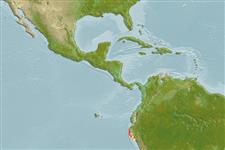>
Eupercaria/misc (Various families in series Eupercaria) >
Sciaenidae (Drums or croakers)
Etymology: Cynoscion: Greek, kyon = dog + Greek, odous = teeth + Greek, skion, skiaina = barbel, red mullet (Ref. 45335).
More on author: Jenyns.
Environment: milieu / climate zone / profondeur / distribution range
Écologie
marin; saumâtre démersal; profondeur 10 - ? m (Ref. 9118). Subtropical; 3°S - 8°S, 82°W - 78°W
Eastern Pacific: Santa Elena, Ecuador to Coquimbo, Chile.
Length at first maturity / Taille / Poids / Âge
Maturité: Lm 23.6 range ? - ? cm
Max length : 47.0 cm TL mâle / non sexé; (Ref. 55763); common length : 30.0 cm TL mâle / non sexé; (Ref. 9118)
Description synthétique
Clés d'identification | Morphologie | Morphométrie
Common species found in coastal waters (Ref. 9118). Juveniles enter estuaries and shallow bays (Ref. 9118). Feeds mainly on shrimps and fishes (Ref. 9118).
Life cycle and mating behavior
Maturité | Reproduction | Frai | Œufs | Fécondité | Larves
Chao, L.N., 1995. Sciaenidae. Corvinas, barbiches, bombaches, corvinatas, corvinetas, corvinillas, lambes, pescadillas, roncachos, verrugatos. p. 1427-1518. In W. Fischer, F. Krupp, W. Schneider, C. Sommer, K.E. Carpenter and V. Niem (eds.) Guia FAO para identificacion de especies para los fines de la pesca. Pacifico Centro-oriental. 3 volumes. 1813 p. (Ref. 9118)
Statut dans la liste rouge de l'IUCN (Ref. 130435: Version 2025-1)
Menace pour l'homme
Harmless
Utilisations par l'homme
Pêcheries: commercial; Aquarium: Commercial
Outils
Articles particuliers
Télécharger en XML
Sources Internet
Estimates based on models
Preferred temperature (Réf.
123201): 17.7 - 20.5, mean 20.2 °C (based on 6 cells).
Phylogenetic diversity index (Réf.
82804): PD
50 = 0.5000 [Uniqueness, from 0.5 = low to 2.0 = high].
Bayesian length-weight: a=0.00813 (0.00458 - 0.01442), b=3.07 (2.92 - 3.22), in cm total length, based on LWR estimates for this species & Genus-body shape (Ref.
93245).
Niveau trophique (Réf.
69278): 4.1 ±0.2 se; based on diet studies.
Generation time: 9.2 ( na - na) years. Estimated as median ln(3)/K based on 2
growth studies.
Résilience (Réf.
120179): Milieu, temps minimum de doublement de population : 1,4 à 4,4 années (K=0.12-0.23).
Fishing Vulnerability (Ref.
59153): Moderate vulnerability (43 of 100).
🛈
Climate Vulnerability (Ref.
125649): Moderate to high vulnerability (50 of 100).
🛈
Nutrients (Ref.
124155): Calcium = 72.2 [39.6, 143.0] mg/100g; Iron = 1.01 [0.53, 1.77] mg/100g; Protein = 18.9 [17.4, 20.6] %; Omega3 = 0.376 [0.217, 0.604] g/100g; Selenium = 24.3 [12.5, 47.6] μg/100g; VitaminA = 21.8 [7.3, 72.7] μg/100g; Zinc = 0.729 [0.514, 1.066] mg/100g (wet weight);
